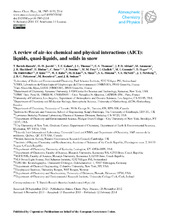| dc.contributor.author | Bartels-Rausch, Thorsten | eng |
| dc.contributor.author | Jacobi, Hans-Werner | eng |
| dc.contributor.author | Kahan, Tara F. | eng |
| dc.contributor.author | Thomas, Jennie L. | eng |
| dc.contributor.author | Thomson, Erik S. | eng |
| dc.contributor.author | Abbatt, Jonathan P.D. | eng |
| dc.contributor.author | Ammann, Markus | eng |
| dc.contributor.author | Blackford, Jane R. | eng |
| dc.contributor.author | Bluhm, Hendrik | eng |
| dc.contributor.author | Boxe, Christopher S. | eng |
| dc.contributor.author | Dominé, Florent | eng |
| dc.contributor.author | Frey, Markus M. | eng |
| dc.contributor.author | Gladich, Ivan | eng |
| dc.contributor.author | Guzmán, Marcelo I. | eng |
| dc.contributor.author | Heger, Dominik | eng |
| dc.contributor.author | Huthwelker, Thomas | eng |
| dc.contributor.author | Klán, Petr | eng |
| dc.contributor.author | Kuhs, Werner F. | eng |
| dc.contributor.author | Kuo, Min H. | eng |
| dc.contributor.author | Maus, Sønke | eng |
| dc.contributor.author | Moussa, Samar G. | eng |
| dc.contributor.author | McNeill, V. Faye | eng |
| dc.contributor.author | Newberg, John T. | eng |
| dc.contributor.author | Pettersson, Jan B.C. | eng |
| dc.contributor.author | Roeselovà, Martina | eng |
| dc.contributor.author | Sodeau, John R. | eng |
| dc.date.accessioned | 2015-10-06T09:41:08Z | |
| dc.date.available | 2015-10-06T09:41:08Z | |
| dc.date.issued | 2014-02-12 | |
| dc.Published | Atmospheric Chemistry And Physics 2014, 14(3):1587-1633 | eng |
| dc.identifier.issn | 1680-7324 | en_US |
| dc.identifier.uri | https://hdl.handle.net/1956/10551 | |
| dc.description.abstract | Snow in the environment acts as a host to rich chemistry and provides a matrix for physical exchange of contaminants within the ecosystem. The goal of this review is to summarise the current state of knowledge of physical processes and chemical reactivity in surface snow with relevance to polar regions. It focuses on a description of impurities in distinct compartments present in surface snow, such as snow crystals, grain boundaries, crystal surfaces, and liquid parts. It emphasises the microscopic description of the ice surface and its link with the environment. Distinct differences between the disordered air–ice interface, often termed quasi-liquid layer, and a liquid phase are highlighted. The reactivity in these different compartments of surface snow is discussed using many experimental studies, simulations, and selected snow models from the molecular to the macro-scale. Although new experimental techniques have extended our knowledge of the surface properties of ice and their impact on some single reactions and processes, others occurring on, at or within snow grains remain unquantified. The presence of liquid or liquid-like compartments either due to the formation of brine or disorder at surfaces of snow crystals below the freezing point may strongly modify reaction rates. Therefore, future experiments should include a detailed characterisation of the surface properties of the ice matrices. A further point that remains largely unresolved is the distribution of impurities between the different domains of the condensed phase inside the snowpack, i.e. in the bulk solid, in liquid at the surface or trapped in confined pockets within or between grains, or at the surface. While surface-sensitive laboratory techniques may in the future help to resolve this point for equilibrium conditions, additional uncertainty for the environmental snowpack may be caused by the highly dynamic nature of the snowpack due to the fast metamorphism occurring under certain environmental conditions. Due to these gaps in knowledge the first snow chemistry models have attempted to reproduce certain processes like the long-term incorporation of volatile compounds in snow and firn or the release of reactive species from the snowpack. Although so far none of the models offers a coupled approach of physical and chemical processes or a detailed representation of the different compartments, they have successfully been used to reproduce some field experiments. A fully coupled snow chemistry and physics model remains to be developed. | en_US |
| dc.language.iso | eng | eng |
| dc.publisher | Copernicus Publications | en_US |
| dc.rights | Attribution CC BY | eng |
| dc.rights.uri | http://creativecommons.org/licenses/by/3.0/ | eng |
| dc.title | A review of air-ice chemical and physical interactions (AICI): Liquids, quasi-liquids, and solids in snow | en_US |
| dc.type | Peer reviewed | |
| dc.type | Journal article | |
| dc.date.updated | 2015-07-28T11:18:41Z | |
| dc.description.version | publishedVersion | en_US |
| dc.rights.holder | Copyright 2014 The Authors | en_US |
| dc.identifier.doi | https://doi.org/10.5194/acp-14-1587-2014 | |
| dc.identifier.cristin | 1153721 | |
| dc.subject.nsi | VDP::Matematikk og naturvitenskap: 400::Geofag: 450::Meteorologi: 453 | |
| dc.subject.nsi | VDP::Mathematics and natural scienses: 400::Geosciences: 450::Meteorology: 453 | |

